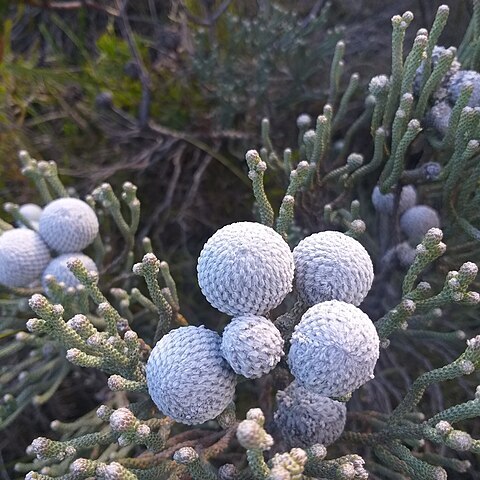Usually 60-90 cm high, with puberulous branchlets. Leaves 3-5 mm long, sessile, imbricate, linear-oblong or oblanceolate-oblong, obtuse, convex on the dorsal surface, almost flat on the ventral surface, slightly incurved, entirely puberulous. Flower-heads about 1.5 cm wide, globose, involucred by acute tomentose modified leaves. Bract spathulate, acute, densely villous on the dorsal surface, less so on the ventral side of the apex, incurved, reaching the tips of the petals. Calyx-tube narrowly obconic, densely villous: calyx-lobes spaced at the base, narrowly linear, villous on the dorsal surface. Petals about 5 mm long, spathulate-linear, obtuse, glabrous, cream-coloured, spreading over the tips of the calyx-lobes, with 2 decurrent wing-line keels on the upper half of the ventral surface, Stamens much exserted: filaments unequal in length (the shortest being adaxial): anthers scarcely 1.5 mm long, oblong, obtuse: thecae free slightly more than 1/2 their length. Ovary 1/2 inferior, densely villous, with 2 imperfectly formed biovulate chambers (the inner edges of the placentas united in the lower half, adjacent in the upper half): ovules collateral, pendulous, styles villous on the lower half. Fruit unknown.
More
Closely leafy, rounded shrub to 1.5 m, coppicing from a woody caudex. Leaves oblong, ascending, incurved above, puberulous above. Flowers in dense, globose heads 1.5-2.0 cm diam., loosely clustered in corymbs, cream-coloured, adaxial filaments shorter.
Closely leafy rounded shrub to 1.5 m, coppicing from a woody caudex. Leaves oblong, ascending, incurved above, puberulous above. Flowers in dense globose, terminal heads 1.5-2.0 cm diam., loosely clustered in corymbs, cream-coloured.


